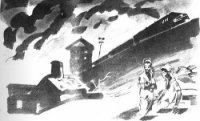Operation Nemesis: The Assassination Plot that Avenged the Armenian Genocide - Bogosian Eric (мир книг .txt) 📗
Harassment and massacre of Armenians had become commonplace, but during the momentous spring of 1915, as Tehlirian’s battle group moved through the Turkish provinces six hundred miles east of his hometown of Erzincan, it still was not clear to them that an all-out eradication program had begun. The confusion of war interrupted communications and obscured the grave intent of the deportations. Tehlirian was overwhelmed by the experience of war nonetheless. Caught between the Cossack advance guard of the Russian army and the Kurdish tribesmen, the civilian populations in the region had been decimated. Towns had been razed, wells poisoned, stores looted. Anyone unlucky enough to have been born on the wrong side of the religious fence had been massacred.
As Tehlirian’s battalion chased the Ottoman army, the empire’s fighters became “bestialized,” to use the jargon of the period, wreaking death as they passed through the defenseless villages. The Muslim fighters were well aware of acts of atrocity that the Russian army had committed against their Bulgarian brethren during the Balkan wars only a few years before. Attacks on civilians were nothing new. The legacy traced back almost a thousand years to the Mongols, the brutality of the Christian Crusaders, and even further back to the Romans. The chain of terror had been forged link by link over centuries and had come to define normal warfare. Atrocity was a means of terrorizing the population and breaking their will to resist. Each side blamed the other, while the civilians paid the price.
In his autobiography, Tehlirian describes the stench of burnt wood and unburied corpses, the plagues of flies. What had begun as an adventure had become an excursion through hell. His psychic torment found no relief in the excitement of battle because the Ottoman army was not there to be confronted. The young Armenian had come to fight the Turks; instead, he buried the dead. Not yet twenty years old, in six short months Tehlirian had traveled a long way, both geographically and psychically.
One evening as dusk fell, after a long day of marching, Tehlirian and his group discovered a cluster of twenty young female corpses, their “eyes glassy with fear.”8 His mind reeled. Was this happening everywhere? Was this going on in Erzincan? What about his own family? Were they safe? Violence was dismantling Tehlirian’s sense of self. Fainting spells plagued him. He suffered from graphic nightmares in which cadavers burst from their graves, shook off their dirty shrouds, and morphed into armies of vengeful skeletons.
Tehlirian was finally issued a weapon and saw sporadic action. Untested and unreliable, he was not a natural-born fighter. He prayed for his life as bullets whizzed past his head while, mortally wounded, his friends fell all around him. He was not a coward, but he was too agitated to throw himself into the battle with unthinking energy. At one point the fighting built to such intensity that he passed out in the midst of a firefight.
In May of 1915, the Russian and Armenian forces had finally entered what remained of Van, a major fortress city on the eastern edge of the empire. Before the war, Armenian Christians had represented a majority of the population in Van. Over the decades, along with Zeitoun, another mountainous enclave in the middle of Anatolia, Van had become one of the most independent-minded of Christian provinces. As such it attracted revolutionaries, not to mention the attention of the Ottoman government. Earlier that winter, certain they were about to be attacked by the Ottoman army, the local Christians fortified their city and prepared for battle. These preparations incited the military to attack, and soon a full-scale battle for the city was under way. The Turks called it a “revolt” and brought in the artillery regiments. The Armenians stood their ground and a bloodbath ensued.9 Tehlirian was seeing for the first time the destructive force of full artillery regiments. He was seeing for the first time the complete destruction of a major Armenian population center.
By August 1915, Tehlirian had ended up back in the Armenian city of Yerevan, well behind the Russian-Ottoman lines. Refugees, terrified of what might befall them should the Ottoman army catch up, had trailed the Russian troops, now unexpectedly in retreat, as they relinquished territory. Thousands of starving refugees poured into the city. Bit by bit, Tehlirian discovered the fate of the Armenians back in Erzurum vilayet. He devoured an Armenian newspaper from Tiflis that described a ragged caravan of deportees arriving in Kharpert after having traveled for two months, deprived of adequate food and water. The caravan had been deported from his hometown of Erzincan.
Tehlirian also set a task for himself: collecting up orphans. Some of the children had seen their parents murdered. Some had escaped the caravans. Starving mothers, no longer able to care for their children, would arrive from distant villages and abandon their young ones in the streets of Yerevan, hoping for the best. The children had “gone crazy, gone wild,” and clung together in packs, having learned to avoid adults. They were always on the move, begging for scraps of bread as they scratched at the lice infesting their rags. Tehlirian recounts, “Such [children] could only be caught at dawn, asleep in the doorways of stores, under tree trunks, at corners of deserted streets, or among the ruins of destroyed buildings, because as soon as they awoke, they could not be caught.” The most difficult children were the little boys who had escaped the Kurds and were trying to find their way back to their villages. These traumatized boys, eight to twelve years old, were quiet and defensive. When queried about the whereabouts of their parents, they had a standard response: “They all killed.” Tehlirian, confused and frightened himself, sought solace by soothing the anxious children. He tells the story of one boy bursting into tears as he described how his parents were “killed in an oven.”10
Collecting the children became Tehlirian’s single focus. Tashnags believed that each child was precious, essential to the future of the Armenian people. They were symbols of hope. Soghomon needed these children to live and to thrive so he could believe that there was a future, any future. He knew that with most adults gone, these small boys needed men in their lives to act as father figures. He would take on that role, even though he was not yet twenty himself. Tehlirian’s work had doubly changed him: it had sickened him physically and it hardened his will to fight.
In early 1916 the Armenians had grown increasingly demoralized. The British general Ian Hamilton had abandoned the overland campaign to take Gallipoli, and thus any attempt to invade Constantinople. This was a significant turn: if the British could not take Turkey proper, the killings of Armenians would continue until the war was over. Tehlirian and his cohorts also understood that Russia and Great Britain had never formed a true coalition, that the so-called Allies were fighting two separate wars.
In March 1916 the Russians made one last push into Asia Minor. The thrust got as far as Erzurum and Tehlirian’s town of Erzincan. Entering the ruined streets, Tehlirian could see that the Turkish sector had been left intact, although Russian flags now flew over the buildings. But when he entered the Armenian district, he found that “everything was gone.” Portions of walls were all that remained of the burned-out buildings. Only the Armenian church, the center of the neighborhood, remained. In his words, Soorp Sarkis Church had become “orphaned.” Even the fruit orchards had been chopped down. “Everything was wrecked.” Directly opposite the church stood Tehlirian’s former home. He approached it with trepidation. A Russian officer stopped him and asked him to state his business. Tehlirian replied, “This is our house. I want to see it.” The officer asked him where his family was now. He answered, “I don’t know.” The Russian took out tobacco and offered it to him in sympathy. The house had been turned into a barracks for Russian soldiers.11




